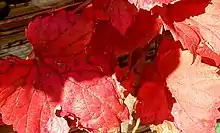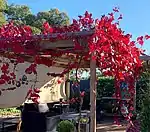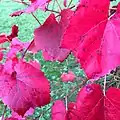Vitis 'Ornamental Grape'
Vitis 'Ornamental Grape', also known as ornamental grapevine, Ganzin glory, glory vine and crimson glory, is a nonfruiting ornamental plant that is a hybrid of Vitis vinifera (Aramon noir) and Vitis rupestris (Alicante Ganzin).[1][2]
| Vitis 'Ornamental Grape' | |
|---|---|
 Fall colours | |
| Genus | Vitis |
| Hybrid parentage | Vitis vinifera × Vitis rupestris |
| Origin | France |
Origins
The vine was bred in 1879 by Victor Ganzin (1838-1900 in Le Pradet near Toulon in France, who had anticipated to mix the fruit characteristics of V. vinifera with V. Rupestris's resistant feature to root damage by phylloxera. It was collected at the CSIRO at Merbein, where it was imported from the Viticultural Research Station at Nuriootpa, South Australia in 1963 and was called 'Tinto' (syn. `Teinturier Male').[3]
Description

The ornamental grape is hardy and generally nonfruiting, vigorously growing, deciduous vine with glossy leaves that have a coppery colour when young which mature to greyish green, and would then turn to amber and orange in early autumn, and would become a brilliant scarlet or crimson by mid-autumn. The leaves tend to be entire to moderately three-lobed, having a thin V-shaped petiolar sinus. The leaves and shoots are representative of hybrids between Vitis vinifera and Vitis rupestris.[1]
It grows to a height of 32 metres and reaches a width of 3 metres and, like the other Vitis species, it climbs by using twining tendrils.[4]
Inflorescence and fruit
The vine produces numerous inflorescences of male flowers with plenteous pollen and a strong fragrance. The inflorescences would then abscess, but occasionally a few flowers produce functional ovaries and at times develop some very small blackish fruit if the climate allows it to, though they don't normally last on the plant and they tend to taste bitter, although birds consume them.[5]
Cultivation
In Australia, the vine is grown for its impressive leaves that turn brilliant red, scarlet, purple and as well as orange in autumn. Easily grown from cuttings, it thrives in a range of climates from hot and dry, to cool moist and subtropical, but would colour best in cooler climates under a sunny spot.[6] It is grown widely in South Australia and has been popular in the state since the early 20th century. It is also present in Mildura and is cultivated elsewhere in Victoria and New South Wales, where it is usually grown over a pergola or fence.
It is oftentimes called 'Ornamental Grape', but is sold by nurseries under a number of different names, such as 'Crimson Glory', 'Glory Vine', 'Alicante Bouschet', `Teinturier' or `Teinturier Male'.[7] It can get fungal leaf diseases in humid coastal climates.[8]
Gallery
 Leaves changing colour with season
Leaves changing colour with season Trailing on trellis
Trailing on trellis Growing on pergola
Growing on pergola Purplish red fall foliage
Purplish red fall foliage Green leaves with emerging inflorescence
Green leaves with emerging inflorescence Close view of the sweet-scented inflorescence
Close view of the sweet-scented inflorescence
See also
- Vitis coignetiae, an ornamental grapevine that produces fruit and is also known as 'crimson glory'
References
- Ganzin, V. (1882). Les premiers hybrids d'Aramon par V. rupestris. Vigne arnér. Vitic. Europe 6:78-81.
- GANZIN 9 Julius Kühn-Institut - Federal Research Centre for Cultivated Plants (JKI), Institute for Grapevine Breeding - Geilweilerhof (ZR)
- De Castella, F. (1942). " The grapes of South Australia: reports to the Phylloxera Board". (Adelaide: Phylloxera Board of S.A.).
- An autumn shade of red by Fiona Ogilvie from The Land, 3 June 2018
- Galet, P. (1962). "Cépages et vignobles de France. Tome III, les cépages de cuve", p. 1842. (Montpellier: Paysan du Midi).
- Ornamental Grape Yates, a division of DuluxGroup (Australia) Pty Ltd
- Bailey, L.H. (1947). "The standard cyclopedia of horticulture". Vol. 3, p. 3491. (New York: Macmillan).
- Ornamental Grape by Burke's Backyard